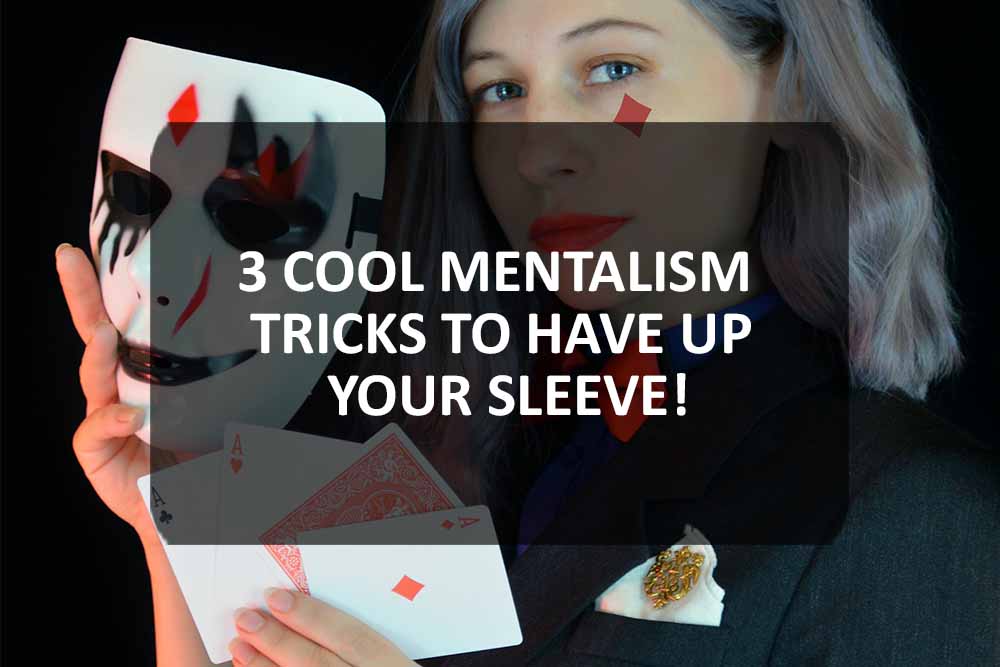Great mentalists make the most of any opportunity they come across. In this light, you have to be prepared to do performances on the spot.
Well, we’re here to give you 3 cool mentalism tricks to have up your sleeve!
No matter where you are, you can perform these tricks for anyone.
So let’s get straight into it.
Cool Trick #1: Personal Matters
Unlike some mentalism tricks that work best when you do it with a single spectator, this is most effective for a group. But not just a group of any size — three is ideal.
What You Need
- A sheet of paper
- A marker
- A container
How You Do It
Having an unfamiliar group as your audience is an advantage. If you’re performing for a group of friends, choose three with whom you’re not particularly close.
Because you’ll be asking for rather personal information, having spectators you’re unaccustomed to is better, so no one thinks you arranged it beforehand.
With that in mind, here are the steps to perform the trick.
- Take the sheet of paper, fold it into thirds, and tear it by hand.
- Hand out a piece to each of your spectators.
- Keep an eye on who gets the middle piece. Tell the participant who has it to write down the name of someone special to them. If your spectator is someone you know, tell them to choose someone you don’t know.
- In comparison, ask the other two spectators to write down the names of people who they don’t like.
- Ask the participants to fold their papers once they’ve written the names. It’s best if you prepare a separate piece so you can demonstrate this step. Say that they should fold it all the same way, so it’s more challenging for you.
- You can turn your back and give your spectators a couple of minutes to complete step 5.
- Once they’re done, bring out a container and have them place their pieces in it.
The Reveal
For effect, remind them you have no idea what names they put in.
Now say you’re going to read the name of the loved one.
Reach in, pick the name of the person the second spectator wrote down, and reveal it.
What’s the Secret
The way you tear the paper is integral to this trick, which is why you need to be aware of who gets the middle piece. It’ll be the only one with two jagged edges instead of one.
Even without looking at the contents, you’ll be able to tell which paper has the correct name.
You can choose to pick out one of the other pieces first and then say you sense the name of the person on the paper is not liked. It builds more drama rather than just pulling out the correct piece right away.
Cool Trick #2: Impromptu Mind Reading
This prediction trick is an awesome one to keep up your sleeve since you don’t need a lot of props to pull it off.
The way it’s done leaves a certain amount to chance, but we’ve considered all possible outcomes to make sure you can navigate your way to a successful reveal regardless of which situation you encounter.
What You Need
- Eight pieces of paper
- A marker
How You Do It
Since this is a prediction trick, this is how to begin it.
- Take a piece of paper and write down your prediction.
- Fold it up and set it down somewhere where the spectator can see it – it shows him that you don’t touch it until the reveal.
Moving on…
- Ask your spectator to call out names of common household pets. As they mention each one, write it on a piece of paper and set it down on the table. Ball up every sheet, so you end up with eight paper balls.
- Take four out of the eighth paper balls and give them a shake inside your hands.
- Ask your spectator to get the remaining half and do the same.
- After that, switch up the paper balls between you and your spectator and shake them up again.
The Reveal
- Put all eight paper balls on the table and have your participant pick one.
- Give him a chance to change his mind. Once your spectator makes his final choice, open it up.
- Now, compare it to the prediction that’s been sitting on the table the entire time.
Miraculously, it says the SAME THING.
What’s the Secret
Although this trick seems to leave a lot to chance, there are several things you can do to ensure it still turns out the way you want it to.
Here are the things you’ll need to keep in mind when doing this cool trick:
Play with probabilities. The first thing you do is write down your prediction, which depends on what you’re going to ask your spectator to name.
Let’s say you go with house pets. A safe prediction will either be a dog or a cat. Because you’re giving your participant eight chances to name some, either one is bound to come up sooner or later.
It’s not just all about house pets, though. You can go with food or colors. Whatever your central topic is, make sure you know what most people will answer and make that your prediction.
Influence your spectator. Phrase your instructions accurately. Saying “common household pets” is more likely to bring up a cat and a dog.
Know where your prediction is ALL the time. This trick requires a great deal of participation from your spectator — from the balling up of the paper pieces to shaking them around. The only paper whose location you need to know at all times is the one with your prediction in it, so in our case, the one that says dog or cat.
During the part where you take half of the paper balls and shake them in your hands, your prediction has to be with you.
For instances that require you to move the paper balls around — like when you take half of the paper balls to shake — a finger palm allows you to keep your prediction in place. A finger palm is loosely gripping the paper ball with your ring and middle finger. If you angle your hand correctly, your spectator won’t see you do it.
When you drop the paper balls back on the table, release your finger palm and make sure you know where your prediction is. Your next step is to give your spectator your half of the balls to shake — since there are eight on the table, push four that are closer to you (giving the impression these were the ones you were holding earlier) towards your spectator. Unknown to him, the prediction is still with you.
Hope for two possible best-case scenarios. When you ask your spectator to choose one of the eight paper balls, it might look like a free choice, but it’s not. You can do several things to influence him.
Position the balls in such a way wherein your prediction is slightly separated from the others. A shape that works best is having seven balls form a semi-circle around a single piece (the one that contains what you wrote in your prediction), with the opening directed towards your spectator.
Having the semi-circle facing your spectator gives him a clear path towards the prediction ball. Having the other pieces surrounding it puts a psychological spotlight on your prediction. It increases the chances that your spectator will choose it. There are two ideal scenarios:
- Best-Case Scenario 1: Your spectator chooses the prediction first. If this happens, open up some other paper balls to see what’s written before asking your participant to unroll his.
- Best-Case Scenario 2: Your spectator chooses the prediction last. If he chooses one of the other paper balls first, then set it aside. Keep asking him to choose another one until only the prediction ball is left. Similar to the first scenario, unroll several before asking your spectator to open his.
Prepare for the worst-case scenario. But what if your spectator chooses the prediction ball somewhere in the middle? First of all, don’t panic!
Continue as you would with Best-Case Scenario 2 (until there’s one left), but remember where your prediction is. When you’re down to the last ball, recap what you did earlier. It allows you to get all the paper balls in your hands. At this point, finger palm your prediction.
When you set the papers down on the table, leave your prediction in your hand — let’s say you’re using your right. Use your left hand to pick up the last piece and prepare to switch it. You do this by pretending to transfer it to the hand holding your prediction.
Instantaneously, show the prediction ball in your right hand and use your left to push all the eliminated balls to one side. It’s the perfect moment to include the real last piece with the others.
This movement may take a bit of time to practice, but it brings excellent results. And once you get the hang of it, you can also use it for other tricks.
Cool Trick #3: Ashes on the Arm
Last on our list is a mind-reading trick that involves fire. It involves several techniques, all of which you can develop with a bit of practice.
What You Need
- A notepad
- A marker
- A lighter
- An ashtray
- A small piece of transparent wax or colorless lip balm
How You Do It
Follow these steps here:
- Ask your spectator to think of a name and write.
- Hand your spectator a small notepad where she can write it down.
- Have your spectator tear off the sheet and return the pad to you.
- Tell your spectator to show the audience what word she wrote down. Turn around so you won’t see anything.
- When you turn back to your spectator, ask her to place the sheet of paper in the ashtray and use the lighter to set it on fire. It turns into ash after a couple of minutes, which is what you want.
The Reveal
Roll up your sleeves and smear the ashes all over your arm.
The name your spectator wrote begins to appear!
What’s the Secret
There are two parts to this trick: figuring out what name your spectator wrote and making it appear on your arm.
The first secret lies in your pad. A couple of pages beneath the page where you want your spectator to write the name, place a piece of carbon paper. When she writes it down, the pad creates an impression.
After having your spectator tear off the sheet where she wrote the name, ask her to show it to the audience. Quickly use this time to do two things:
- Flip through the pad to see what your spectator wrote
- Use the wax or lip balm to write it on your arm
Because the lip balm is colorless, it won’t leave a mark on your arm — not until you smear the ashes from the burnt paper. Those will stick to balm and show the name.
In Conclusion
It’s always good to have some tricks up your sleeve — those that you can easily pull out if an opportunity to show your mentalism skills comes up.
The three we shared here don’t require a lot of props and have minimal setup.
However, it’s not an excuse to rest on your laurels. Being confident is one thing. Being overconfident is another.
So take the time to practice to make sure you deliver a fantastic performance.

